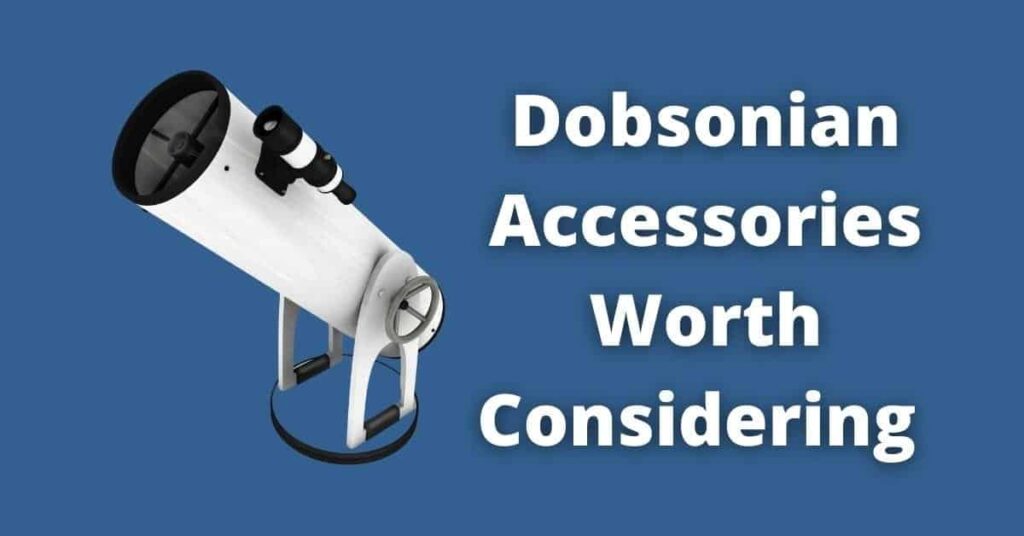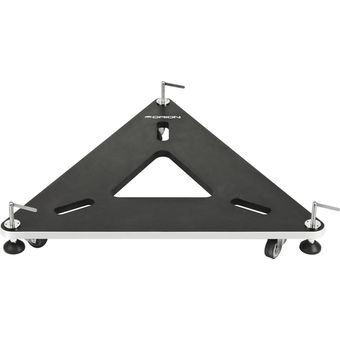If you’ve bought a Dobsonian telescope, you may be wondering, what else you need for a good experience in using it.

Dobsonians have a few advantages over other types of telescopes. Here’s what you can accessorize them with for a next-level experience.
Telescope accessories list
Here is a list of accessories to consider to complement your Dobsonian.
the best finderscope for Dobsonian
A finderscope is important in how to find planets and target other celestial bodies, e.g., bright stars and clusters so that you can point your telescope to observe these.
Dobsonians come with finderscopes like most telescopes do. But the straight-through types that are standard with these are uncomfortable to use. That’s my experience. One of the first accessories I purchased for my Dobsonian was a right-angle finderscope for comfort’s sake – I now don’t have to contort my body just to see through it.
The right-angle finderscope has a prism to show the image the ‘right way up’. It’s still an optical finderscope, like the straight-through. An alternative is the Red Dot finderscope. I explain the benefits of these in my article that compares Red Dot with the optical types.
The standard finderscope shows the image upside-down — I wrote why it is in my article about solving upside images in telescopes and telescope finderscopes.
Red flashlight is a must
A red flashlight is a must-have for backyard astronomers to preserve night vision that’s essential for better views of distant objects. I cover this in more detail in my article about maintaining dark-adapted eyes.
Covers and caps
Keep your telescope away from moisture and dust (I wrote about what happens if it gets wet). And, I also wrote about the problem of dust on lenses and how to get rid of it.
I share ideas about how to do this properly in my article on the storage of telescopes. You definitely need covers for the lenses. In most cases, these come with your purchase. If you happen to lose them or break them, it’s important to get replacements.
Extra eyepieces
You’ll get at least two eyepieces with your telescope. In most cases, these will get you by as they’ll be generalist types. As you get more experienced, you may want to go beyond these capabilities and try different magnifying power. I wrote an article on buying extra eyepieces to help with this.
Barlow lens
Some telescope purchases come with a Barlow lens. If not, you might want to buy one. A Barlow lens multiplies the power of your eyepiece and can reduce the number of eyepieces you need in your telescope kit. The quality of the piece is important. You can find out more and how to use one in my article on Barlow lenses.
Filters
Filters for your eyepieces allow you better views by way of adding contrast. If there is one filter to buy first up, it’s a lunar filter. The Moon is an object everyone can enjoy looking at all year round. Moon filters are a neutral gray and help reduce glare so the Moon features stand out more.
Filters come in different colors to remove certain wavelengths of light. I’ll cover this in more detail in a future article.
I’ve written about solar filters, which are needed when viewing the Sun for sunspots and during eclipses.
Sky maps
You need to know your way around the sky, so sky maps or planispheres are important. These show you where to see certain constellations or bright stars as well as the position of planets.
Apps on your device can serve this purpose or you can buy hardcopy planispheres or books with sky charts included.
I recommend getting a hardcopy version. These have an advantage over the apps in cases where you don’t have an internet connection or when your device happens to be low on power.
Observing seat
This is an optional extra, but a good idea to have an observer’s seat as standing looking at the sky can take its toll. You can get ones that are adjustable in height, like this one…

Ergonomic Seat by Vestil
available at Amazon (affiliate link)
Dob Dolly or trolley
A 6″ or higher Dobsonian is fairly bulky. You might want to consider a trolley or dob dolly to transfer it from its storage space or from your vehicle to the viewing spot. I have a basic trolley with sturdy casters that I have mine seated on while stored and then use it to move it around.
See the Dob Dolly at Orion. The beauty of this one is that once in position you can stabilize it by dropping the risers to lift the dolly so the casters are no longer on the ground and able to move.

Designed for use with 4.5, 6, 8 and 10 Dobsonians, the Dob Dolly provides a rugge… [More]
(affiliate link)
Maintenance kit
Cleaning: You’ll need a kit with a soft brush and lens cleaner for maintenance.
Collimation tool: Check out the info I wrote on what you need for the collimation of Dobsonians. Options include a collimation cap (also called a sight tube), Cheshire, and a laser collimator.
Stargazing guides
I suggest you include at least one Stargazer’s guide. Here’s one that I recommend, if you are in the Northern Hemisphere:
- Nightwatch, a Practical Guide to Viewing the Universe by Terence Dickinson (available at Amazon – affiliate). This book contains sky charts and has a spring binding so is practical for use on location.
- Astronomy Australia Year Guide to the Night Sky (affiliate link) by Wallace, Dawes, and Northfield includes all sky maps and much more information for stargazing down under
You’ll find more in my list of recommended books.
